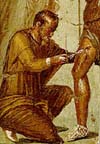 I watched an interesting program on The History Channel about combat medicine through the centuries and it was very favorable towards Roman battlefield medicine. The Roman used silver wound staples because they are hypoallergenic and their surgical clamps were almost identical to clamp design in modern 21st century hospitals.
I watched an interesting program on The History Channel about combat medicine through the centuries and it was very favorable towards Roman battlefield medicine. The Roman used silver wound staples because they are hypoallergenic and their surgical clamps were almost identical to clamp design in modern 21st century hospitals.
An excellent site by a physicians daughter,Tanya Marton, pointed out that Augustus founded the first professional army medical corps.
"Augustus, realizing that they were key in an empire and especially an army, gave all physicians that joined his new army medical corps dignified titles, land grants, and special retirement benefits!. . . At the beginning of the first century, all army doctors were required to attend the new army medical school, and by the third century, all doctors, both civilian and army, were required to pass medical school."
"Interestingly, the Romans did not yet really understand how germs related to disease, but they did use many of the techniques that killed germs, techniques that were not reinvented until much later. For example, they boiled their tools before use and would not reuse the same tool on a patient before reboiling. Wounds were washed with "acetum," which is actually a better antiseptic than Joseph Listers carbolic acid (Joseph Lister rediscovered antiseptics in the 1860s, based on Louis Pasteurs brand-new germ theory of disease). "
"Over the years, Roman war doctors also learned how to prevent many battlefield epidemics. They accomplished this by placing forts AWAY from insect infested swamps. They also installed drains and sewers to transport sewage away from the men. Similarly, they invented sophisticated permanent hospitals, with specialized rooms for different tasks, and with isolation of some patients from others to reduce the spread of disease. Central heating and good ventilation also helped patients."
The Roman also introduced the battlefield "medic": "One Roman innovation was providing limited medical training to certain soldiers who remained with the troops. These soldiers functioned as combat medics who provided far-forward care to injured soldiers, such as using bandages to control bleeding. The army also had special units which evacuated soldiers from the battlefield to the field hospitals where they were treated by medical personnel."
Jenny Booth of the London Telegraph reported the discovery of a Roman-amputated thigh bone in October, 2000. The femur was found in a tomb near the city of Portus in Italy. (http://omega.cohums.ohio-state.edu/hyper-lists/classics-l/00-11-01/0301.html)
"THE first evidence that doctors in ancient Rome were able to carry out successful amputations has been uncovered by anthropologists. A 2nd
Century thigh bone found in a cemetery near Rome clearly shows the serrated marks of a surgeons saw. The amputee was a tall man who must
have survived for months or even years after his operation, because the bone had started to heal. This suggests that the surgeons were skilled
enough to fashion a flap of tissue to sew over the amputated end, protecting it from the air. "
No comments:
Post a Comment